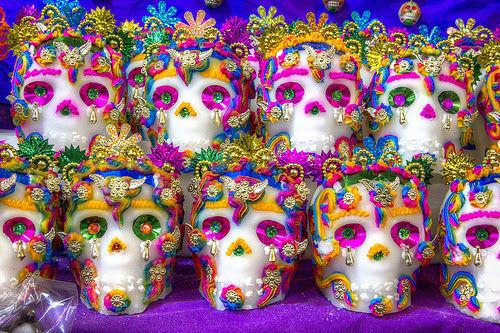Día de Muertos– the Day of the dead– is a holiday celebrated on November 1–2. It is a very strong tradition for the Mexican culture, honoring the dead with festivals and celebrations.
People may relate death to sadness and grief, but in Mexico it’s a happy day; a day where people joyfully remember their loved relatives that have died, with food, drinks, parties, and activities that they enjoyed in life. The Day of the Dead recognizes death as a natural part of the human experience and shows you not to fear death.
Día de Muertos traditions include creating ofrendas, which are altars to honor the dead, and they are created inside of people’s homes; these altars offer the dead the things they enjoyed the most when they were alive. They are usually on tables and include their favorite food, candles, photographs of the deceased, sugar skulls, flowers, and some have also liquor and cigarettes.
The community embraces Día de Muertos, so altars are also created in schools, government offices, and other community spaces; they even hold contests for the best offrenda.
On this day families also go and visit their lost ones in the graveyard, to clean their graves and decorate them with Mexican marigolds called cempasúchil; they can also build an ofrenda there.
This day is supposed to be when the dead return to earth and celebrate their lives, and that’s why they can also put gifts on the Ofrenda. It will attract their loved ones, helping them find their way back to their families on earth. The burning candles also help guide their way back.
This day is all about remembering. So to honor the dead, they tell funny stories about them, sometimes written in a poem (known as calaveras). It is believed that the dead do not want to be remembered in a sad way, and that they want to be remembered and celebrated, since they are still alive, but in another form.
On the last days of October, the whole country prepares for Día de Muertos.
In the State of Mexico, they prepare a fair (Feria del alfeñique). It consists of stands that offer all types of colorful figures allusive to death; the most popular are skulls made of sugar, but you can also find skulls made of chocolate. You can even personalize your sugar skull and write your name on it. These stands also sell “Pan de Muerto” (Day of the Dead bread) which has a very particular design; it has strips of dough simulating bones and at the top a small round piece of dough that symbolizes teardrops– this bread is only available on the months of October and November.
The whole point of celebrating Día De Muertos is to make contact with your lost ones and let them know they have not been forgotten, and that on earth they are remembered, not in a sad way but in a happy way.





















































